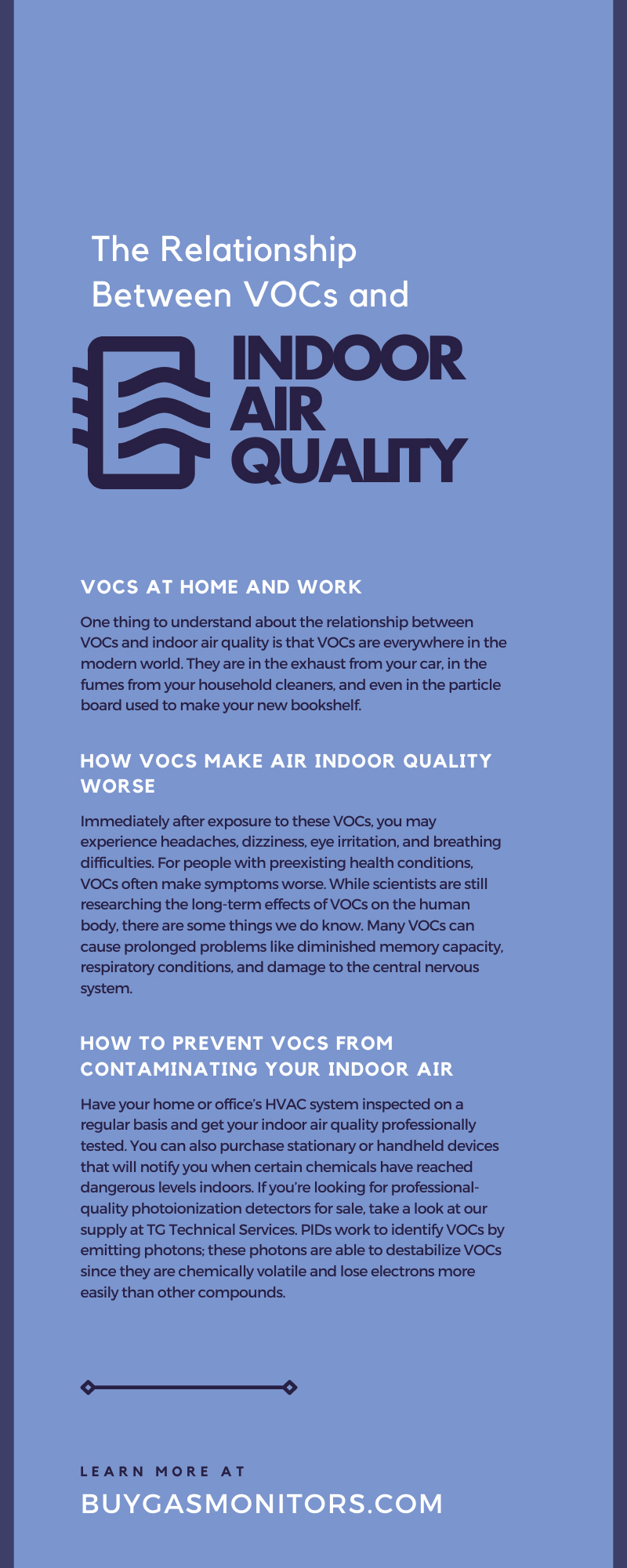The Relationship Between VOCs and Indoor Air Quality
Posted by William Kimmell on 4th Nov 2022
One thing that all human beings have in common is the need to breathe good, clean air. When there are toxic chemicals and microparticles in the air we breathe, our health can suffer. Scientists are still studying the risks of long term exposure to some kinds of gases, meaning we still don’t have the full picture of exactly how these air contaminants impact the human body.
Volatile Organic Compounds (VOCs) is the name for this large category of poisonous and sometimes deadly chemicals that can taint the air around us. While many of them occur naturally, they can be very dangerous when human beings try to harness their power for cleaning, construction, and fuel. Doing so brings these VOCs into much closer human contact than they would normally be in nature. Learn more about the relationship between VOCs and indoor air quality below.
What Good Indoor Air Quality Looks Like
In general, there are three components to what good air indoor air quality looks like:
- Plenty of ventilation bringing in clean air
- Few air contaminants
- Temperatures and humidity levels that are pleasant and prevent mold growth
Here’s what these principles look like when applied in a home or office. During the winter, the indoor temperature should be between 68-75 degrees Fahrenheit; during the summer, it should be 75-80 degrees. At all times of the year, humidity should never be higher than 60% to avoid encouraging mold growth.
In addition to temperature and humidity that is safe and comfortable, the ideal indoor space will also have few contaminants, like VOCs and microparticles (think dust, pollen, and soot). To help get rid of contaminants, there will be plenty of ventilation bringing in fresh air. This means it’s very important that your exterior ventilation ports are not near sources of contamination.
Signs of Bad Indoor Air Quality
Bad indoor air quality can happen when there is a problem with any of the three principles listed above. For example, if you have poor ventilation and a higher level of air contaminants, those contaminants will build up, and you’ll begin to notice them. Pollen and dust may cause sneezing and coughing, while toxic fumes may produce feelings of dizziness and headaches. In some cases, houseplants may get sick and die if there are high concentrations of VOCs in the air.
If the humidity in your home or office is too high, you may start to see mold growing on surfaces more quickly than normal. Good places to check for mold are in showers and toilets, since the presence of water can raise the humidity slightly.
Pro-Tip: Fighting Back Against Pollen
People with allergies often struggle to keep pollen out of their homes and offices. Even with otherwise good indoor air quality, pollen seems to find a way inside. The trick is to change your clothes once you get home, since pollen sticks to surfaces. Additionally, wash your clothes as soon as possible instead of letting them pile up.
Understanding VOCs at Home and Work
One thing to understand about the relationship between VOCs and indoor air quality is that VOCs are everywhere in the modern world. They are in the exhaust from your car, in the fumes from your household cleaners, and even in the particle board used to make your new bookshelf. While it’s nearly impossible to rid the air in your home or office from all VOCs, you can restrict their concentration using the following techniques:
- Never leave vehicles running inside the garage
- Only use cleaners in well-ventilated spaces
- Let new ready-to-assemble furniture pieces air out in the garage or outdoors before bringing them inside
- Only use soy and beeswax candles
- Use electric appliances instead of gas
- Use non-acetone nail polish remover
- Never mix cleaners other than as directed on the label
- Use cleaners with environmentally-friendly ingredients
The list above is not exhaustive, but its should give you a place to start. Following this list is also not an excuse for neglecting the other two parts of good indoor air quality: good ventilation and appropriate temperature and humidity settings.
How VOCs Make Air Indoor Quality Worse
VOCs make indoor air quality worse by polluting the air we need to breathe. Instead of clean oxygen, we’re breathing in other chemicals, including the following:
- Acetone: solvent for nail polish, varnish, and paint
- Butanol: solvent for fats, waxes, resin, and used in animal medication
- Ethanol: used in medicine as a topical antiinfective, found in polishes, plastics, and cosmetics
- Formaldehyde: fungicide and disinfectant, used in labs and manufacturing
- Dichloromethane: paint solvent, used to extract fats and oils in food technology
Immediately after exposure to these VOCs, you may experience headaches, dizziness, eye irritation, and breathing difficulties. For people with preexisting health problems, VOCs often make symptoms worse.
While scientists are still researching the long term effects of VOCs on the human body, there are some things we do know. Many VOCs can cause long term problems like diminished memory capacity, respiratory conditions, and damage to the central nervous system. Scientists also suspect that at least some VOCs can cause cancer in both animals and humans.
How to Prevent VOCs from Contaminating Your Indoor Air
In addition to the tactics listed above, which allow you to control VOCs through avoidance of certain behaviors, there are more active steps you can take. Have your home or office’s HVAC system inspected on a regular basis and get your indoor air quality professionally tested. You can also purchase stationary or handheld devices that will notify you when certain chemicals have reached a dangerous level indoors.
If you’re looking for professional-quality photoionization detectors for sale, take a look at our supply at TG Technical Services. PIDs work to identify VOCs by emitting photons. These photons are able to destabilize VOCs, since they are chemically volatile and lose electrons more easily than other compounds. The process creates an electrical current that the device picks up on, allowing it to measure the presence of VOCs.
Call or email TG Technical services today if you’re looking to take active steps toward improving your indoor air quality. Doing so will help safeguard your health both now and in the future.


